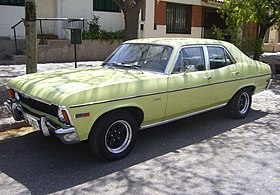
Chevrolet is an American automobile division of the manufacturer General Motors (GM). Louis Chevrolet (1878–1941), Arthur Chevrolet (1884–1946) and ousted General Motors founder William C. Durant (1861–1947) started the company on November 3, 1911 as the Chevrolet Motor Car Company. Durant used the Chevrolet Motor Car Company to acquire a controlling stake in General Motors with a reverse merger occurring on May 2, 1918, and propelled himself back to the GM presidency. After Durant's second ousting in 1919, Alfred Sloan, with his maxim "a car for every purse and purpose", would pick the Chevrolet brand to become the volume leader in the General Motors family, selling mainstream vehicles to compete with Henry Ford's Model T in 1919 and overtaking Ford as the best-selling car in the United States by 1929 with the Chevrolet International.

The Chevrolet Impala is a full-size car that was built by Chevrolet for model years 1958 to 1985, 1994 to 1996, and 2000 to 2020. The Impala was Chevrolet's popular flagship passenger car and was among the better-selling American-made automobiles in the United States.

The Chevrolet Chevelle is a mid-sized automobile that was produced by Chevrolet in three generations for the 1964 through 1977 model years. Part of the General Motors (GM) A-body platform, the Chevelle was one of Chevrolet's most successful nameplates. Body styles included coupes, sedans, convertibles, and station wagons. The "Super Sport" versions were produced through the 1973 model year and Lagunas from 1973 through to 1976.
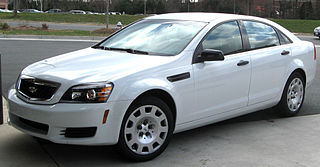
The Chevrolet Caprice is a full-size car produced by Chevrolet in North America for the 1965 to 1996 model years. Full-size Chevrolet sales peaked in 1965 with over a million sold. It was the most popular car in the U.S. in the 1960s and early 1970s, which, during its lifetime, included the Biscayne, Bel Air, and Impala.

The Chevrolet Bel Air is a full-size car produced by Chevrolet for the 1950–1981 model years. Initially, only the two-door hardtops in the Chevrolet model range were designated with the Bel Air name from 1950 to 1952. With the 1953 model year, the Bel Air name was changed from a designation for a unique body shape to a premium level of trim applied across a number of body styles. The Bel Air continued with various other trim level designations, and it had gone from a mid-level trim car to a budget fleet sedan when U.S. production ceased in 1975. Production continued in Canada, for its home market only, through the 1981 model year.

The Chevrolet Chevette is a front-engine, rear-drive subcompact manufactured and marketed by Chevrolet for model years 1976–1987 as a three-door or five-door hatchback. Introduced in North America in September 1975, the Chevette superseded the Vega as Chevrolet's entry-level subcompact, and sold 2.8 million units over 12 years. The Chevette was the best-selling small car in the U.S. for model years 1979 and 1980.
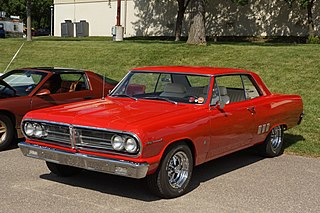
Acadian is a model of automobile produced by General Motors of Canada from 1962 to 1971. The Acadian was introduced so Canadian Pontiac-Buick dealers would have a compact model to sell, since the Pontiac Tempest was unavailable in Canada. Plans originally called for the Acadian to be based on the Chevrolet Corvair, which was produced at GM's Oshawa plant; however, the concept was moved to the Chevy II platform to be introduced for 1962. The brand was also offered in Chile, with models built in Arica.

The Chevrolet Aveo (T200) is the first generation of the Chevrolet Aveo, a subcompact automobile nameplate from the Chevrolet division of the American manufacturer General Motors. The T200 was launched in 2002, developed by the initially-independent South Korean manufacturer Daewoo, later GM Korea. It was originally marketed as the Daewoo Kalos and prominently marketed with the Chevrolet brand as the Aveo. The model received the T200 internal codes during the car's development. The T250 code was designated for the model's major facelift.

The Chevrolet Malibu is a mid-size car manufactured and marketed by Chevrolet from model years 1964–1983 and since 1997. The Malibu began as a trim-level of the Chevrolet Chevelle, becoming its own model line in 1978. Originally a rear-wheel drive intermediate, GM revived the Malibu nameplate as a front-wheel-drive car in 1997.
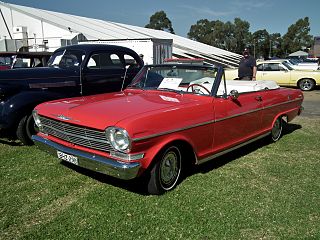
The Chevrolet Chevy II/Nova is a small automobile manufactured by Chevrolet, and produced in five generations for the 1962 through 1979, and 1985 through 1988 model years. Nova was the top model in the Chevy II lineup through 1968. The Chevy II nameplate was dropped after 1968, with Nova becoming the nameplate for all of the 1969 through 1979 models. Built on the X-body platform, the Nova was replaced by the 1980 Chevrolet Citation introduced in the spring of 1979. The Nova nameplate returned in 1985, produced through 1988 as a S-car based, NUMMI manufactured, subcompact based on the front wheel drive, Japan home-based Toyota Sprinter.

The Pontiac Parisienne is a full-size rear-wheel drive vehicle that was sold by Pontiac on the GM B platform in Canada from 1958 to 1986 and in the United States from 1983 to 1986. Right-hand drive models were locally assembled in Australia, New Zealand, and South Africa until 1969. For most of its run, the Canadian Parisienne was nearly mechanically identical to the American Chevrolet Impala or Chevrolet Caprice. The Parisienne wagon continued under the Safari nameplate until 1989. Parisienne or La Parisienne means a grammatically female person or thing from Paris, France.

The Chevrolet Cobalt is a compact car introduced by Chevrolet in 2004 for the 2005 model year. The Cobalt replaced both the Cavalier and the Toyota-based Geo/Chevrolet Prizm as Chevrolet's compact car. The Cobalt was available as both a coupe and sedan, as well as a sport compact version dubbed the Cobalt SS. Like the Chevrolet HHR and the Saturn ION, it was based on the GM Delta platform.

The Chevrolet Spark is a city car manufactured by General Motors's subsidiary GM Korea from 1998 to 2022. The vehicle was initially developed by Daewoo and was introduced in 1998 as the Daewoo Matiz. In 2002, General Motors purchased Daewoo Motors, which had the vehicle being marketed with several GM marques and nameplates.

Beaumont was a make of mid-sized automobiles produced by General Motors of Canada from 1964 to 1969. These cars were based on the Chevrolet Chevelle, but the line had its own logo and nameplate, and was neither marketed nor actively sold in the United States. Its logo consisted of an arrow, similar to that of Pontiac, but with a maple leaf to signify its dual heritage from both sides of Lake Ontario.
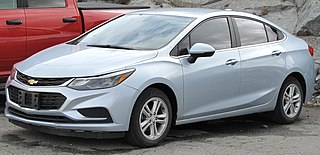
The Chevrolet Cruze is a compact car that has been produced by General Motors since 2008. It was designated as a globally developed, designed, and manufactured four-door compact sedan, complemented by a five-door hatchback body variant from 2011, and a station wagon in 2012. During its introduction, the Cruze replaces several compact models, including the Chevrolet Optra which was sold internationally under various names, the Chevrolet Cobalt sold exclusively in North America, and the Australasian-market Holden Astra.

The Chevrolet 400 was a compact car made by General Motors de Argentina from 1962 to 1974. The "400" was General Motors's reply to Ford and Chrysler after those companies introduced the first compact cars to Argentina, the Ford Falcon and Valiant II respectively.

The Chevrolet Aveo is a subcompact car (B-segment) marketed by General Motors (GM) since 2002. Originally developed by South Korean manufacturer Daewoo Motors and marketed as the Daewoo Kalos, the takeover of Daewoo by GM to form GM Daewoo Auto & Technology (GMDAT) resulted in the car being marketed under seven brands in 120 countries, with the Aveo nameplate being the most commonly used one. The second-generation Aveo, developed by GM Korea, was introduced in 2011 and was also marketed as the Chevrolet Sonic in several markets such as in the Americas, Japan, Middle East, South Africa and several Southeast Asian markets. Production of the second-generation model ended in October 2020.

The Opel Corsa is a supermini car engineered and produced by the German automobile manufacturer Opel since 1982. Throughout its existence, it has been sold under a variety of other brands owned by General Motors and also spawned various other derivatives.
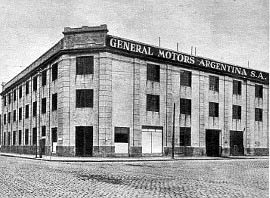
General Motors de Argentina S.R.L. is the Argentine subsidiary of the US-based company General Motors. The company is currently headquartered in Vicente López, Buenos Aires, with its factory located in Alvear, Santa Fe Province.

The Chevrolet Turbo-Thrift engine is a straight-six produced from 1962 to 2001 by the Chevrolet division of General Motors. The entire series of engines was commonly called Turbo-Thrift, although the name was first used on the 230 cubic inch version that debuted in 1963. The new engine featured seven main bearings in lieu of the four bearing design of its predecessor, the "Stovebolt" engine, and was considerably smaller and approximately 100 lbs lighter.
